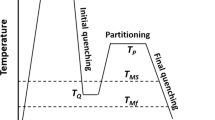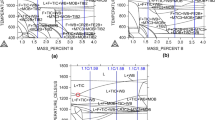Abstract
We investigated the influence of phosphorus (0.02–0.76%) on the microstructure, short-term strength, cyclic crack resistance characteristics, and micromechanism of fatigue fracture of grey and high-strength cast irons. It was established that the low cyclic crack resistance of grey and high-strength cast irons with increased phosphorus contents (0.7–0.8%) is caused by the propagation of a fatigue crack via intergranular cleavage, initiated by a discontinuous or continuous network of precipitates of the ternary fine-grained phosphide eutectic along boundaries of ferrite grains. We showed that, from the viewpoint of cyclic crack resistance, it is admissible to alloy cast irons of the ferritic and ferritic–pearlitic class with phosphorus up to 0.3% when the phosphide eutectic forms in amounts of 3–5% for grey cast irons and 4–7% for high-strength cast irons without significant decrease in their resistance to brittle fracture.
Similar content being viewed by others
REFERENCES
E. Houdremont, Handbuch der Sonderstahlkunde [Russian translation], Vol. 2, Metallurgiya, Moscow (1966).
V. V. Lunev and V. V. Averin, Sulphur and Phosphorus in Steel [in Russian], Metallurgiya, Moscow (1988).
K. P. Bunin, Ya. N. Malinochka, and Yu. N. Taran, Foundations of the Metallography of Cast Iron [in Russian], Metallurgiya, Moscow (1969).
I. P. Volchok, A. O. Egorov, and G. I. Slyn'ko, “The micromechanism of fracture and properties of phosphoric cast irons,” in: V. V. Panasyuk (editor), Fracture Mechanics of Materials and Strength of Structures [in Ukrainian], Issue 2, Vol. 1, Kamenyar, Lviv (1999), pp. 208–220.
N. G. Girshovich, Crystallization and Properties of Cast Iron in Castings [in Russian], Mashinostroenie, Moscow (1966).
A. D. Sherman and A. A. Zhukov (editors), Cast Iron. A Handbook [in Russian], Metallurgiya, Moscow (1991).
S. Ya. Yarema, “A method for determination of the crack growth rate and crack resistance characteristics under cyclic loading,” Fiz.-Khim. Mekh. Mater., 30, No. 3, 137–152, No. 4, 121–136, No. 6, 101–112 (1994), 31, No. 1, 145–157 (1995).
I. N. Bogachev, Metallography of Cast Iron [in Russian], Metallurgizdat, Sverdlovsk (1962).
A. P. Lyubchenko, High-Strength Cast Irons [in Russian], Metallurgiya, Moscow (1982).
O. N. Romaniv, A. N. Tkach, T. Ya. Yus'kiv, et al., “Growth of a fatigue crack in cast irons. Part 2. Grey and malleable cast irons,” Fiz.-Khim. Mekh. Mater., 26, No. 3, 33–40 (1990).
O. N. Romaniv, A. N. Tkach, T. Ya. Yus'kiv, et al., “Growth of a fatigue crack in cast irons. Part 2. Nodular cast iron,” Fiz.-Khim. Mekh. Mater., 25, No. 4, 73–79 (1989).
O. P. Ostash, E. M. Kostyk, I. M. Andreiko, and M. M. Dronyuk, “Effect of the microstructure on the low-temperature cyclic crack resistance of high-strength cast irons,” Fiz.-Khim. Mekh. Mater., 33, No. 1, 57–69 (1997).
Author information
Authors and Affiliations
Rights and permissions
About this article
Cite this article
Andreiko, I.M., Slyn'ko, H.I., Ostash, O.P. et al. Cyclic Crack Resistance of Grey and High-Strength Cast Irons with Increased Phosphorus Content. Materials Science 36, 849–856 (2000). https://doi.org/10.1023/A:1011382604316
Issue Date:
DOI: https://doi.org/10.1023/A:1011382604316




